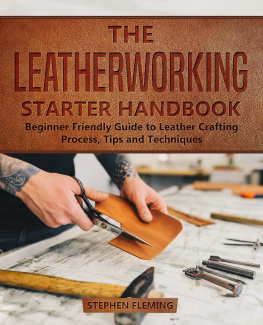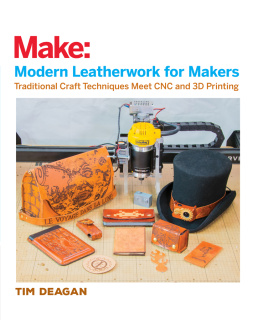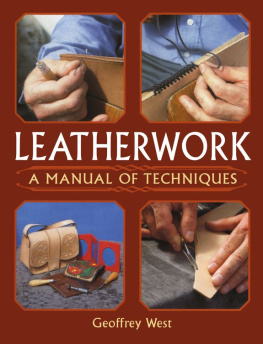The Leatherworking Starter Handbook:
Beginner Friendly Guide to Leather Crafting Process, Tips and Techniques
Stephen Fleming

Revised Edition April 2020
Bonus Booklet
Thanks for purchasing the book. In addition to the content, we are also providing an additional booklet consisting of Monthly planner and Project Schedule template for your first project.
Also, it has five evergreen patterns for your practice.
Download the booklet by typing the below link.
http://bit.ly/leatherbonus
Cheers!

Copyright 2020 Stephen Fleming
All rights reserved.
.
Table of Contents
Introduction to Leather Crafting
Gouging and Folding Leather
Leather Crafting, Physical Pain & Ergonomics
PREFACE
While starting Leather Crafting way back in 2014, I was desperately looking for a go-to guide about the processes and the tools involved.
The online content was information overload and not presented in a step-by-step manner. The books I referred were either focused on a few processes or assumed that I had the necessary information. Also, I found that most of the books were a little outdated.
There are two ways of learning; one is learning from subject matter experts who have years of experience or learning from people who are just a few steps ahead of you in their journey.
I am the latter. Five years into this hobby, and Im still learning from the experts.
I still remember the initial doubts I had and the tips which helped me.
This book is for beginners (0-3 years) of the leather crafting journey who want a holistic idea of processes and tools and who need help in their initial projects.
Included are photographs of realistic projects by beginners explaining the process and standard operating procedure while starting.
In the Appendix, I have provided a list of online resources available for free patterns, tips, and techniques.
Cheers, and lets start the journey.
Stephen Fleming
1. Introduction to Leather Crafting
Tips for Beginners
- All the knowledge you gained after watching how-to videos is meaningless until you pick up the tools and get on with your first project.
- If possible, take a class/session (online or offline) to see if this hobby is for you before investing cash into it.
- Learn the basics initially (pattern transfer, wetness monitoring, swivel knife control, etc.).
- Don't over complicate every little thing.
- Failures and stress will undoubtedly happen at some point. Remember, in the beginning, the leather beats you more often!
- Do not hesitate to ask questions, no matter how silly they seem.
- Before asking a question, check first to see if its already been asked and answered by someone online or offline. (Do your homework)
- You don't always need the latest as well as the most expensive tools. Bear in mind that a great device costs a couple of additional dollars (3 to 5 times the cost of essential tools), however, the high-end tools are typically ten or twenty times the price of the basic tools. The most expensive tools do not come with talent or experience. Choose carefully as per your budget.
- As you grow in the craft and are ready to spend more, upgrade your tools. Buy them as they are needed. Do not be that person that acquires everything upfront and never makes use of fifty percent of it.
Beginners Roadmap

Step 1: Decide with which type of leatherwork you intend to start your journey
Do you want to learn fine-tuned European design, Western Americana techniques, or a rustic type of leatherwork? Each of these approaches requires different tools and methods, depending on what you're looking for in your finished product.
Are you only looking to build a standard leather bag or purse, or would you also like to add a wow factor such as slanted stitches that require an intermediate level of craftsmanship?
So, decide the style and level of expertise you would like to achieve in your first phase of learning.
Even better, figure out the projects you would like to work on initially. It would help you to be more focused during the learning process.
Step 2: Find out the tools you'll need for your type of leatherwork.
Once you decide what sort of leatherwork you intend to craft, you should obtain the right tools for the work.
The tools vary with the type of leatherwork you choose for your initial projects.
In the case of rustic leatherwork, you can make use of a lot of in-house tools. However, for more finished artwork, you would need a sewing clam or pony as well as sewing knives to create those ideal stitches.
Step 3: Identify what you want to make and obtain the appropriate leather
Once you decide on what you plan to make, you can identify what kind of leather suits your project. Two of the most common leathers are chrome-tanned leather and veg-tanned leather.
These two types of leather have several distinctions consisting of how they're tanned, the kind of colors they can acquire, and their amount of flexibility and softness.
If, for example, you're making a belt and you prefer heavy veg-tanned leather, choose a minimum of 7oz weight leather instead of chrome-tanned leather, which would be soft and flexible and would stretch after some time.
Step 4: While doing saddle-stitching use a premium linen thread
Making use of better materials is most likely to give you the desired outcome. Also, when the process involves stitching, which is very crucial and takes a lot of time and effort, it is suggested to use all-natural linen thread, which is durable and used traditionally.
Step 5: Practice and master the technique
When it comes to leatherwork, it's all about learning the basic steps and following each step carefully.
Make sure that you are following the sequential steps for the desired outcome.
For instance, if you're looking for a refined and professional look, then make sure you are following sewing standards and also doing the edge finishing! Edge finishing is the step where you make use of wax and burnish your edges, so they're smooth as well as polished looking.
Step 6: Have fun with traditional leather craft!
The art of leatherwork, pyrography, and whittling belongs to a time when we were in the non-digital world. The aim was to spend quality time and make something creative.
So enjoy the craft, spend time with your loved ones by involving them, and yes, keep your mobile phones at bay!
Next page














